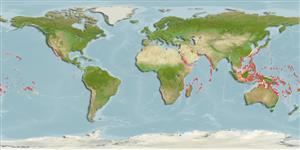Ophionereis dubia (Müller & Troschel, 1842)
Striped brittlestar| Native range | All suitable habitat | Point map | Year 2050 |

|
| This map was computer-generated and has not yet been reviewed. |
| Ophionereis dubia AquaMaps Data sources: GBIF OBIS |
Google image |
No photo available for this species.
Classification / Names Common names | Synonyms | CoL | ITIS | WoRMS
Ophiuroidea | Amphilepidida | Ophionereididae
Environment: milieu / climate zone / depth range / distribution range Ecology
Reef-associated; depth range 0 - 30 m (Ref. 107858). Subtropical
Distribution Countries | FAO areas | Ecosystems | Occurrences | Introductions
Indo-West Pacific. Questionable in Pitcairn.
Length at first maturity / Size / Weight / Age
Maturity: Lm ? range ? - ? cm
Life cycle and mating behavior Maturity | Reproduction | Spawning | Eggs | Fecundity | Larvae
Main reference
References | Coordinator | Collaborators
Fujita, T. and Y. Liao 2001 Ophiuroids (Echinodermata) collected in the shallow water of Hainan Island, South China Sea. In pp. 95-99, Matsura, K. (ed). 2001. Marine Fauna of the Shallow Waters Around Hainan Island, South China Sea. National Science Museum Monographs 21:95-99. (Ref. 81187)
IUCN Red List Status
(Ref. 130435: Version 2025-1)
CITES status (Ref. 108899)
CMS (Ref. 116361)
Threat to humans
Human uses
| FishSource |
Tools
More information
Max. ages / sizes
Length-weight rel.
Length-length rel.
Length-frequencies
Mass conversion
Abundance
Internet sources
BHL | BOLD Systems | CISTI | DiscoverLife | FAO(Publication : search) | Fishipedia | GenBank (genome, nucleotide) | GloBI | Gomexsi | Google Books | Google Scholar | Google | PubMed | Tree of Life | Wikipedia (Go, Search) | Zoological Record


